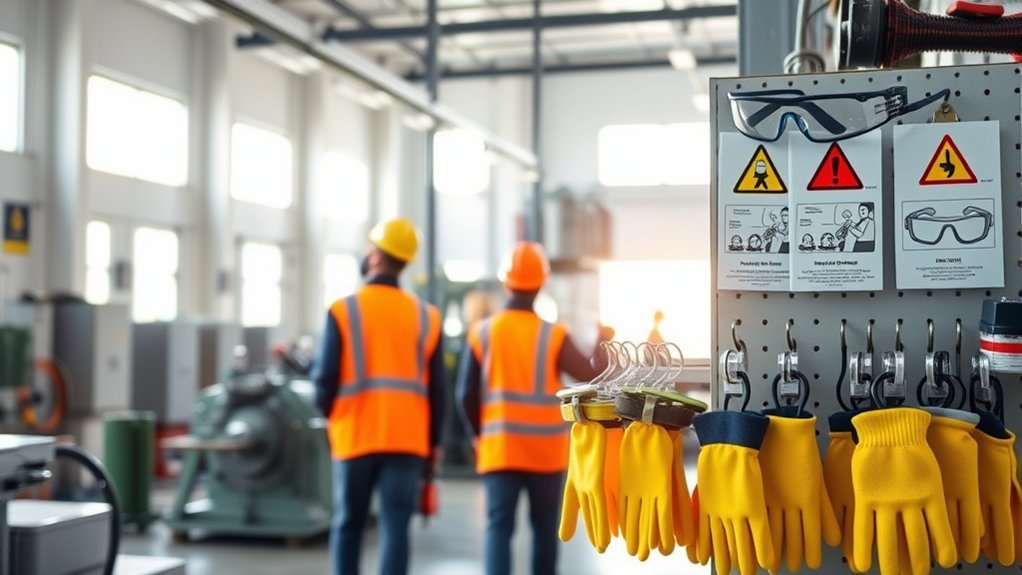Understanding safety standards is essential for anyone responsible for health and well-being in their environment. These standards provide a framework for reducing risks and ensuring compliance. You might wonder how these standards are developed, the types that exist, and what happens if you don’t comply. Let’s explore these questions and uncover what it takes to create a safe and productive atmosphere.
What Are Safety Standards and Why Are They Important?
Safety standards are essential guidelines that help guarantee the health and well-being of individuals in various environments, whether at work, home, or in public spaces.
These standards set the bar for acceptable practices, ensuring everyone can operate in a safe atmosphere. You mightn’t realize it, but adhering to safety standards minimizes risks, reduces accidents, and enhances overall productivity.
By following these guidelines, you empower yourself and those around you to navigate environments confidently. Furthermore, safety standards foster a culture of accountability and responsibility, encouraging everyone to prioritize their well-being.
Empowering yourself and those around you fosters confidence and accountability, creating a safer and more responsible environment for all.
Ultimately, understanding and implementing these standards leads to a more liberated and secure existence, where you can thrive without fear of harm in everyday situations.
Types of Safety Standards: An Overview
Understanding safety standards is just the initial step; recognizing the different types can help you apply them effectively in various settings.
There are several key categories of safety standards. First, you have performance standards, which outline the required outcomes for safety measures. Next, there are design standards, focusing on how equipment or processes should be constructed to guarantee safety.
You’ll also encounter operational standards that guide how tasks should be performed safely. Additionally, regulatory standards are established by authorities, mandating compliance for safety.
Finally, voluntary standards, while not legally binding, offer best practices for safety. By familiarizing yourself with these types, you empower yourself to make informed decisions and foster a safer environment.
How Are Safety Standards Developed and Regulated?
How do safety standards come to be? They’re developed through a collaborative process involving industry experts, government agencies, and stakeholders.
These groups identify potential hazards and assess risks associated with products, processes, or environments. Once they’ve gathered sufficient data, they draft standards that guarantee safety and reliability.
These proposed standards undergo thorough review and public comment, allowing you to voice concerns and recommendations. After this feedback is incorporated, the standards are finalized and published.
Regulatory bodies then enforce compliance, monitoring industries to guarantee adherence. This ongoing evaluation allows for updates as new technologies and risks emerge, guaranteeing that safety standards remain relevant and effective.
Ultimately, this process aims to protect you and your community from harm.
What Are the Consequences of Non-Compliance?
Non-compliance with established safety standards can lead to serious repercussions for both individuals and organizations.
For individuals, the risks include injury or even fatality, which can create a lasting impact on families and communities. You might face legal actions, resulting in fines or penalties.
For organizations, the consequences can be dire—financial losses, reputational damage, and potential shutdowns due to litigation or regulatory interventions. Your employees may also feel unsafe, leading to decreased morale and productivity.
Ultimately, ignoring safety standards undermines trust and accountability, hindering progress. To guarantee a safe environment, it’s essential to prioritize compliance.
Embracing safety standards not only protects you but also fosters a culture of responsibility and respect in your community.
How Can Businesses Ensure Compliance With Safety Standards?
Ensuring compliance with safety standards is essential for protecting both employees and the organization itself.
Compliance with safety standards is crucial for safeguarding employees and the organization as a whole.
Here are four effective ways you can achieve this:
- Conduct Regular Training: Provide ongoing safety training for all employees to keep them informed about current standards and practices.
- Implement Safety Audits: Schedule frequent audits to assess your compliance status and identify areas for improvement.
- Establish Clear Policies: Create and communicate clear safety policies that outline expectations and procedures for handling safety issues.
- Encourage Reporting: Foster an open environment where employees feel comfortable reporting potential hazards without fear of repercussions.
Frequently Asked Questions
Who Enforces Safety Standards in Different Industries?
Various government agencies enforce safety standards across industries, including OSHA for workplace safety, the FDA for food and drug safety, and the EPA for environmental regulations. Each agency guarantees compliance and protects public health and welfare.
How Often Are Safety Standards Updated or Revised?
Safety standards aren’t set in stone; they’re updated regularly, often every few years, to keep pace with new technology and emerging risks. You’ll find that staying informed keeps you empowered and ahead of potential hazards.
What Role Do Employees Play in Safety Standards Compliance?
You play an essential role in safety standards compliance by actively following protocols, reporting hazards, and participating in training. Your vigilance and commitment guarantee a safer workplace for everyone, empowering you and your colleagues to thrive.
Can Safety Standards Vary by Region or Country?
Absolutely, safety standards can shift like the wind across different regions and countries. You’ll find varying regulations, shaped by local cultures and conditions, impacting how safety is approached in workplaces everywhere you go.
Are There Penalties for Reporting Unsafe Practices?
Yes, there can be penalties for reporting unsafe practices, especially if done maliciously or without evidence. However, many regions protect whistleblowers to encourage reporting, fostering a safer environment for everyone involved.
Conclusion
In conclusion, safety standards are essential for protecting health and minimizing risks in any environment. By understanding and adhering to these guidelines, you not only guarantee compliance but also foster a culture of safety that boosts productivity. Remember, “an ounce of prevention is worth a pound of cure.” Regular training and audits can help you stay on track, so make safety a priority in your organization to safeguard both your employees and your business.
